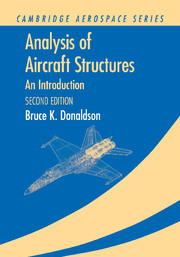Book contents
- Frontmatter
- Contents
- Introduction to the Second Edition
- Introduction to the First Edition
- List of Repeated Engineering Symbols
- Acknowledgments
- Part I The Fundamentals of Structural Analysis
- Part II **Introduction to the Theory of Elasticity**
- 7 The Theory of Elasticity
- 8 Plane Stress Theory of Elasticity Solutions
- Parts I and II Review Questions
- Part III Engineering Theory for Straight, Long Beams
- Part IV Work and Energy Principles
- Part V Energy-Based Numerical Solutions
- Part VI Thin Plate Theory and Structural Stability
- Appendix A Additional Topics
- Appendix B Selected Answers to Exercises
- References
- Index
7 - The Theory of Elasticity
from Part II - **Introduction to the Theory of Elasticity**
Published online by Cambridge University Press: 05 June 2012
- Frontmatter
- Contents
- Introduction to the Second Edition
- Introduction to the First Edition
- List of Repeated Engineering Symbols
- Acknowledgments
- Part I The Fundamentals of Structural Analysis
- Part II **Introduction to the Theory of Elasticity**
- 7 The Theory of Elasticity
- 8 Plane Stress Theory of Elasticity Solutions
- Parts I and II Review Questions
- Part III Engineering Theory for Straight, Long Beams
- Part IV Work and Energy Principles
- Part V Energy-Based Numerical Solutions
- Part VI Thin Plate Theory and Structural Stability
- Appendix A Additional Topics
- Appendix B Selected Answers to Exercises
- References
- Index
Summary
Introduction
Chapters 1–6 developed (i) the general equilibrium equations from a free body diagram (FBD) of a differential rectangular parallelepiped taken from a structural body of any shape and material; (ii) the strain–displacement equations and the equivalent compatibility equations from the geometry of the deformations of the same parallelepiped; and finally (iii) the constitutive equations for the isotropic and orthotropic linearly elastic material models. Again, these three sets of equations, which apply over the interior of the structural body, are called the field or domain equations. The Cauchy equations, which relate the tractions and the stresses at the boundary, were also discussed at length, and mention was made of prescribed displacement equations that specify displacements at the boundary. Again, the Cauchy and the prescribed displacement equations are collectively called the boundary condition equations. Together, the three sets of field equations and the boundary condition equations form the four sets of equations that are the basis for what is called the theory of elasticity. This chapter demonstrates what can be done with these four sets of equations.
There are six unknown stresses, six unknown strains, and three unknown displacements throughout the domain (interior) of the structural body of interest. There are three equilibrium equations, six stress–strain equations, and six strain–displacement equations. Thus there are a total of 15 unknown stresses, strains, and displacements, and 15 independent equations relating those quantities.
- Type
- Chapter
- Information
- Analysis of Aircraft StructuresAn Introduction, pp. 167 - 191Publisher: Cambridge University PressPrint publication year: 2008



